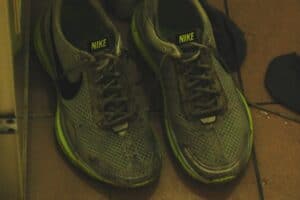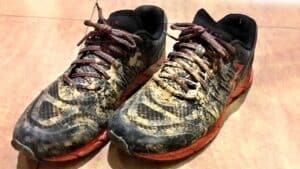One of the most common questions asked by trail runners is how long do trail running shoes last? The answer to this question can vary greatly depending on several factors such as the type of trail running shoes, the runner’s weight, and running technique. In this article, we will explore the different aspects that affect the durability of trail running shoes and provide some guidelines to help you determine when it’s time to replace your running shoes.
Factors Affecting the Lifespan of Trail Running Shoes

1. Type of Trail Running Shoes
There are various types of trail running shoes available in the market, and each of them is designed for specific types of trails and running styles. Generally, most trail shoes tend to be sturdier than road running shoes to provide better support and protection while navigating uneven terrain. However, some trail shoes may be lighter and less durable to cater to runners who prioritize speed over stability.
It is essential to select the right trail shoes based on your running style, the type of terrain you usually run on, and your personal preferences. Wearing shoes that are not suitable for your running needs can lead to excessive wear and tear, reducing the lifespan of your shoes.
2. Runner’s Weight
Another factor that affects how long do trail running shoes last is the runner’s weight. Heavier runners tend to exert more pressure on their shoes, causing the midsole and outsole to compress and wear out faster. If you are a heavier runner, you might need to replace your shoes sooner than lighter runners.
3. Running Technique
Your running technique or stride can also impact the lifespan of your trail running shoes. Runners with a more efficient running stride tend to experience less wear and tear on their shoes compared to those with a less efficient stride. For example, a runner with a heel strike may wear out the heels of their shoes faster than a runner with a toe strike. Additionally, if you tend to drag your feet while running or frequently scuff your shoes against rocks and roots, your shoes may wear out faster than those of other runners.
4. Frequency and Distance of Runs
The more you run, the faster your trail running shoes will wear out. If you run long distances frequently, you will need to replace your running shoes more often than someone who runs shorter distances at a steady pace. It is essential to monitor the wear and tear of your shoes and replace them before they become too worn out to provide adequate support and protection.
5. Terrain
The type of terrain you run on can also affect how long your trail running shoes last. Running on rougher terrain with rocks, roots, and uneven surfaces can cause more wear and tear on your shoes than running on smoother trails. If you frequently run on challenging trails, you might need to invest in sturdier shoes with more durable outsoles to extend the shoe life.
Signs That It’s Time to Replace Your Trail Running Shoes

Knowing how long do trail running shoes last is crucial, but it’s also essential to recognize the signs that indicate it’s time to replace your worn-out shoes. Here are some signs to look out for:
1. Worn outsoles: If the treads on the bottom of your trail shoes are worn out or have little to no grip left, it’s time to get a new pair. Worn out treads can lead to slips and falls on the trail, especially in wet or muddy conditions.
2. Uneven wear: If your shoes show uneven wear on the outsole, it could be an indication of poor shock absorption or an issue with your running technique. Uneven wear can lead to discomfort and potential injuries, so it’s essential to replace your shoes if you notice this issue.
3. Loss of cushioning: As the midsole of your trail running shoes wears out, the cushioning and shock absorption capabilities decrease. If you start to feel more impact on your joints while running, it’s time to invest in a new pair of shoes.
4. Damaged upper: If the upper part of your trail running shoes is torn or damaged, it can compromise the fit and support of your shoes. In such a case, it’s best to replace your shoes to ensure proper protection and comfort.
To extend the life of your trail running shoes, it’s essential to take proper care of them. Make sure to clean your shoes after each run and let them air dry. Avoid exposing your shoes to direct heat sources as it can damage the materials and reduce their lifespan. Rotating between two pairs of shoes can also be beneficial, as it allows each pair enough time to recover and maintain its shape between runs.
In conclusion, there is no one-size-fits-all answer to the question, “how long do trail running shoes last?” The lifespan of your trail running shoes depends on various factors such as your weight, running technique, frequency and distance of runs, and the type of terrain you run on. By monitoring the wear and tear of your shoes and being aware of the signs that it’s time to replace them, you can ensure that you always have the right support and protection while enjoying your trail running adventures.
- How Do I Keep My Feet Dry While Trail Running 7 Top Tips
- How Do You Carry Your Phone While Trail Running
- How Do You Treat A Sprained Ankle On A Trail
- How Does Trail Running Improve Your Balance
- How Far Is An Ultra Marathon
- How Long Can The Average Person Run
- How Long Do Trail Running Shoes Last
- How Many Lumens For Trail Running
- How Often Should You Trail Run
- How To Avoid Getting Ticks
- How To Become A Trail Running Coach
- How To Break In Trail Running Shoes
- How To Carry Water On A Run
- How To Choose Trail Running Shoes
- How To Clean Trail Running Shoes
- How To Deal With Navigational Challenges On Trails
- How To Eat And Drink While Trail Running
- How To Find Trail Running Routes
- How To Get Sponsored For Trail Running
- How To Improve Your Trail Running
- How To Lace Trail Running Shoes
- How To Prepare For Your First Trail Race
- How To Prevent Cramps When Running
- How To Set And Achieve Trail Running Goals
- How To Start Trail Running
- How To Tape An Ankle Before Trail Running
- How To Train For Mountain Trail Running
- How To Train For Trail Running Without Trails 11 Great Tips
- How To Train For Trail Running
- How To Use Poles When Trail Running
- How To Warm Up Before A Trail Run
- How To Wear An Armband While Running
- How Trail Running Helps In Body Toning
